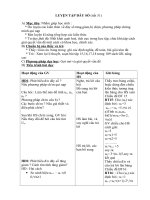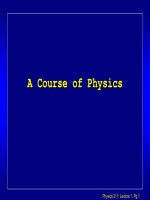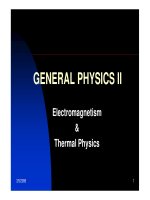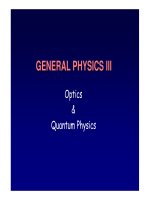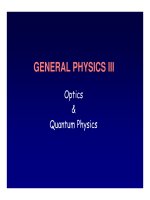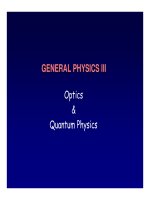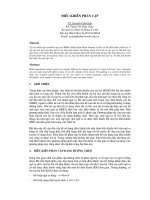- Trang chủ >>
- Khoa Học Tự Nhiên >>
- Vật lý
Tài liệu Chapter XXII Atomic Structure pptx
Bạn đang xem bản rút gọn của tài liệu. Xem và tải ngay bản đầy đủ của tài liệu tại đây (912.93 KB, 35 trang )
GENERAL PHYSICS III
GENERAL PHYSICS III
Optics
&
Quantum Physics
Chapter XXII
Chapter XXII
Atom
Atom
ic
ic
Structure
Structure
§1. Hydrogen atom
§2. Angular momentum of electron
§3. Electron spin
§4. Many-electron atoms
At present it is well known for you that
The Atom - electrons confined in Coulomb field of a nucleus
Au
v
Rutherford (also Geiger-Marsden)
Experiment (1911):
Measured angular dependence of
particles (He ions) scattered
from gold foil.
The results:
• Mostly scattering at small angles. But…
• Occasional scatterings at large angles
(even > 90
o
)
Something massive in there !
Conclusion: Most of atomic mass is
concentrated in a small region of the atom a nucleus!
Recall some history:
Early sugession for the quantum nature of atoms:
(nm)
Atomic hydrogen
Discrete emission and absorption spectra:
• When excited in an electrical
discharge, atoms emitted radiation
only at discrete wavelengths
• Different emission spectra
for different atoms.
This could not be explained by classical physics.
+Ze
-e
F
There is also a BIG PROBLEM with the
classical picture:
As the electron moves in its circular orbit,
it is ACCELERATING radiates electromagnetic
energy would continuously lose energy and
spiral into the nucleus (in about 10
-9
sec).
We must apply QUANTUM MECHANICS to ATOMS
§1. Hydrogen atom:
1.1
Potential energy of the electron
Potential energy of the electron
in the hydrogen atom
in the hydrogen atom:
r
e
)r(U
2
r
U(r)
0
229
0
C/Nm109
4
1
2
2
)(
r
e
r
rU
f
• Make a test:
This potential function implies
actually the Coulomb force
between the electron & the nucleus
x
y
z
r
• The origin of coordinate system is at the center of mass of
the system (nucleus & electron).
• U depends on r, but not on directions in the space.
Such a potential is called spherically symmetrical.
• The problem is 3-D. Due to the spherical symmetry
it is more convenient to use the spherical
coordinates, than Cartersian.
)()()(
)(
2
2
22
xExxU
dx
xd
m
EzyxU
z
x
y
x
x
x
m
),,(
)()()(
2
2
2
2
2
2
22
ErU
rrr
r
rrm
)(
sin
1
sin
sin
11
2
2
2
222
2
2
2
1.2 The time independent SEQ:
• Recall 1-D time independent SEQ:
• The 3-D time independent SEQ is as follows:
• For the hyrdrogen atom, the potential function U(x,y,z) = U(r), and
the SEQ in the spherical coordinate system is
r
e
)r(U
2
Solving and finding the eigenvalues for E and the
eigenfunctions ψ requires some mathematical preparation.
In our course of general physics, we will concentrate on the physical
implications of mathematical solutions.
1.3 Energy levels of the electron in the hydrogen atom:
As you have seen, in the solving the SEQ, the physical conditions for the
wave function (finiteness, single valuedness, continuosness) lead to the
consequence that the energy of the system can not have continuum values,
but must accept a discrete set of values: “the energy levels”.
The energy levels of the electron in the hydrogen atom is found to be
22
o
2
n
n
eV6.13
n
1
a2
e
E
,...3,2,1n
2
2
0
em
a
= “Bohr radius” = 0.053 nm
-15
-10
-5
0
0 5 10 15 20
r/a
0
E (eV)
U(r)
-15
0
0
20
E
2
E
1
E
3
* Notes: Before Schrödinger, N. Bohr
proposed the same scheme of energy
levels for the hydrogen atom in his
theory (1913). But in the Bohr’s theory
the concept of discrete energy levels was introduced as a postulate.
The values of the energy levels are determined by fitting in the
experimental discrete spectra of the hydrogen atom.
2
13.6 eV
n
E
n
2 2
1 1
13.6 eV
i f
n n
i f
E
n n
we have
3 2
1 1
13.6 eV 1.9eV
9 4
photon
E E
1240eV nm
656nm
1.9eV
photon
hc
E
(nm)
Atomic hydrogen
Recall that the discrete spectra of the hydrogen atom is related to the
optical transitions of between the electron’s energy levels.
Example: An electron, initially excited
to the n = 3 energy level of the hydrogen
atom, falls to the n = 2 level, emitting a
photon in the process. What are the
energy and wavelength of the photon
emitted?
-15
-10
-5
0
0 5 10 15 20
r/a
0
E (eV)
U(r)
-15
0
0 20
E
2
E
1
E
3
From
eVEEEE
n
6.130
11
Note: The ionization energy of atomic hydrogen at its ground state is
1.4 The eigenfunctions and physical interpretation:
Due to the spherical symmetry, the solution to
the SEQ in spherical coordinates is found
by the method of separation of variables,
and has the form:
x
y
z
r
),()(),,(
lmnlnlm
YrRr
with quantum numbers: n l and m
principal orbital magnetic
(angular
momentum)
• R
nl
(r) is the ‘radial part’ of wave function.
• Y
lm
(
,
) are the angle-dependent functions called “spherical harmonics.”
• The principal quantum number n = 1,2, 3,… This number is that in the
formula of the energy levels.
• For every n, the values of l are 0, 1, 2,…, (n-1).
• For every l, the values of m are -l, -(l-1), …, -2, -1, 0, 1, 2,…, (l-1), l.
The spherically symmetric states: We write here the wave functions for
wavefunctions with no angular dependence. These are called “s-states”.
For them, l = 0 and m = 0, the function Y
00
= constant, and the part R
n0
(r)
obeys the ‘radial SEQ’ which takes the form:
r
R
30
r
15a
0
0
0
r
R
20
10a
0
0
0
0.5
R
10
0
0
4a
0
0
3/
2
00
0,3
3
2
2
3)(
ar
e
a
r
a
r
rR
o
ar
e
a
r
rR
2/
0
0,2
2
1)(
)r(RE)r(R
r
e
r
r
r
1
m2
0nn0n
2
2
22
)r(R),,r(
0n
s-state
wavefunction:
(l=0)
o
ar
erR
/
0,1
)(
drrrRdVdrrP
n
22
0
2
4)()(
“2s state”
“1s state”
Probability density of electrons:
P(r) is plotted below for the two s-states with n=1,2:
The horizontal axis is in (r/a
0
) units. At
r = a
0
(the Bohr radius) the probabilty
of finding the electron is highest for 1s-state.
The angle dependent part of the eigenfunctions:
The investigation of the
angle dependent part
of the eigenfunctions of
the electron in the hydrogen atom gives the following results:
This part can be represented in the following form:
,)(
im
m
e
)(cos.sin)(
ml
m
lm
F
where
(m takes (2l+1) interger values from –l to +l).
),()(),(
mlmlm
Y
llm ,...,0,...,
,...3,2,1,0l
→ the associated Legendre function
Examples:
,1),(
00
Y → the spherically symmetrical (angle independent)
“s-state” (l=0)
,cos),(
10
Y
,.sin),(
1,1
im
eY
,.sin),(
1,1
im
eY
→ the “p-states” (l=1)
§2.Angular momentum of electron:
Angular momentum L
Z
around the z axis depends on how fast
the phase changes as you rotate around the z-axis.
The phase change is expessed by the factor exp(im) in the angle
dependent part of the eifenfunction
A state with an exact value of L
Z
is of the form:
Re()
r
,
where ( ) ( , )
im
Z l m
L m r Y e
0, , 2 etc
Z
L
e.g. L
Z
can have values in a discrete set
m is called the ‘orbital’ magnetic quantum number,
or shortly, magnetic quantum number.
The results of solving SEQ for the hydrogen atom with the conditions
for the wave functions give also the eigenvalues for the angular moment
2.1 The L
Z
component of the angular momentum vector:
.
Z
L
LL
L
vector
which is specified by
and
).1(...,,2,1,0where)1( nlllL
2.2 Magnitude of orbital angular momentum:
The index l of the eigenfunctions is directly related to the magnitude
of the angular moment
LL
Examples:
(the spherically
symmetrical “s-state”)
00,0 Lml
,0,,21,0,1,1
Z
LLml
.2,,0,,2,6
2,1,0,1,2,2
Z
LL
ml
(the “p-states”)
(the “d-states”)
